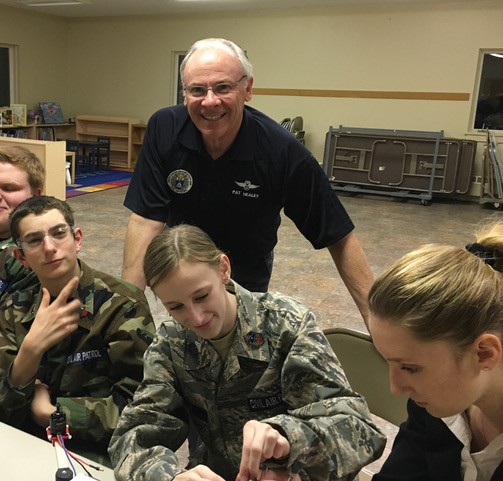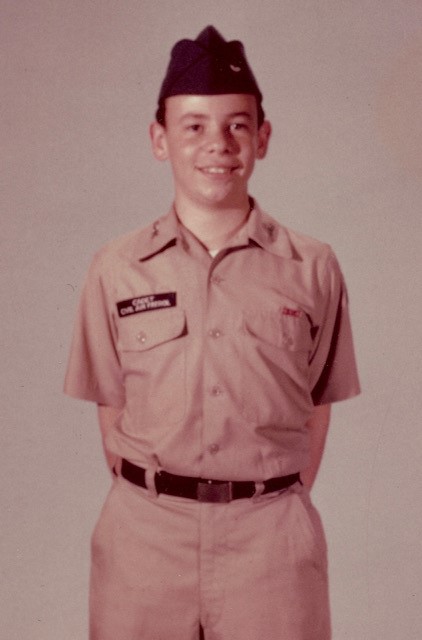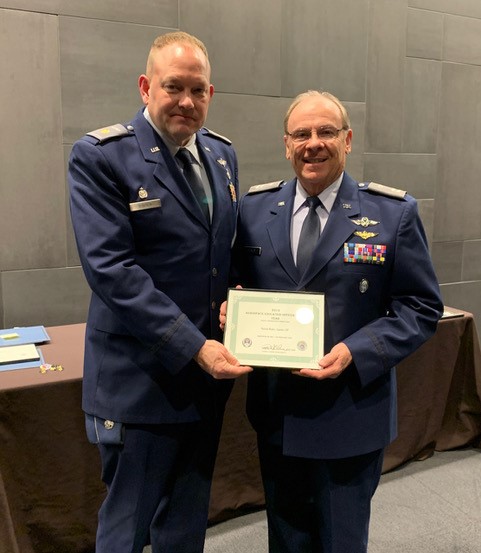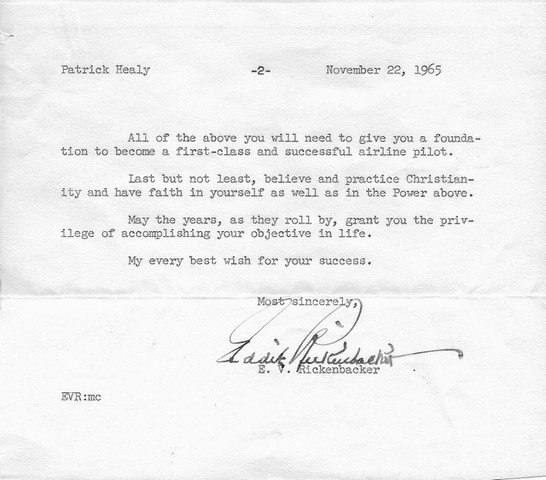Capt. Patrick Healey of Florida Wing is a former CAP cadet and commercial airline pilot
Posted on December 9, 2020 at 10:40 AM by Virginia Smith
 |
| Capt. Patrick Healey of Florida Wing goes beyond just building CAP STEM Kits with his squadron. He introduces background before the cadets build the kit and creates scenarios for using the kits after they are built. |
December 9, 2020
Meet Capt. Patrick Healey of Florida Wing. He is the AEO of St. Augustine Composite Squadron (SER-FL-173) and a CAP pilot and instructor pilot. His Civil Air Patrol career started as a cadet in California in 1964. As a cadet, he studied famed World War I Ace Capt. Eddie Rickenbacker, wrote him a letter asking him how to be an airline pilot and received a personal two-page letter that his mom framed for him. It was his mom and his AEO dentist who convinced him join CAP, but it was his first cadet Orientation Flight that made him stay. He vividly remembers it more than 55 years later. After a flying career with the U.S. Navy and commercial airlines, Capt. Healey retired four years ago and reconnected with Civil Air Patrol. Now, he has changed seats from his cadet orientation flight to be the pilot for cadets today. As an AEO and with the framed Rickenbacker core values letter still in his office, he works to bring aerospace curriculum to life for his cadets so that they can reach their dreams. He has numerous creative ideas for working with CAP STEM Kits and other curriculum. We asked him some questions about his Civil Air Patrol career and his work as an AEO. His answers follow.
Past and current duty positions:
- Aerospace Education Officer (St. Augustine Composite Squadron, SER-FL-173, and previously of Doylestown Composite Squadron 907, NER-PA-146)
- CAP Pilot/Instructor Pilot
How did you get involved in Civil Air Patrol?
My childhood dentist, Col. Richard L. Sharp, USAF Retired, was the AEO in CAP California Squadron 23. He discussed with my mom about taking me to a CAP meeting when I was almost 13. I was a wild and unruly kid, but I liked what I saw, and joined CAP in July 1964. When I was 14, Col. Sharp gave me my first CAP Cadet Orientation Flight. That sparked something inside, and there was no turning
 |
| Capt. Patrick Healey as a cadet. |
back. I found what I love. I remember my first CAP O’ flight vividly as he does. I am still in touch with him, and we have been in touch for the past 56 years. He is 99 years old and we talk occasionally and I ask advice and discuss my AE projects. We talk about the good ol' CAP days with him as my AEO. Basically, I owe my flying career and nice parking spot, to my mom, my AEO dentist and the CAP program.
Tell us about your CAP career path that led to your current role.
After my first O’ Flight, my mom worked extra hard and paid for my flight lessons. I soloed when I was 16. When I was 17 and a cadet captain, I was awarded one of the treasured California slots for the CAP Powered Flight Academy, and CAP allowed me to earn my Private Pilot Certificate at Reno-Stead Air Force Base in 1967. I made it through as a cadet for seven years total and to C/LtCol with proud CAP wings on my chest.
You mention that you were a pilot in the military and then flew with airlines for 33 years. Tell us about your career.
Through my last few years as a CAP cadet, I continued to fly every chance possible. My experience and flight hours built up as did the ratings. I flew some charters, night cargo, flew bank checks. I even transported bodies for a morgue. I did whatever was possible to go flying. Then, I was able to join the United States Navy and earn my Naval Aviator wings of gold.
Six years after I was a CAP cadet, I soloed my first jet in the U.S. Navy. I continued to fly and was West Coast-based flying off of aircraft carriers. My last aircraft was the A-7E Corsair II.
After the military, I kept warmed up with commercial and corporate flying waiting for the airlines to open up. I was hired quickly with a small West Coast airline, and worked my way up through seven airline bankruptcies to settle with and retire four years ago, from United Airlines flying four continents and finally international 767-400s.
I then rejoined the CAP with the local Doylestown, Pennsylvania, squadron 907. After going through the CAP aircraft checkouts and training, a few months later, I was able to fly my first cadet orientation flight. Just before starting the engine, I looked over at my first-time flyer, my front seat cadet C/Airman Andrew Mitchell. He was 14 and looked like me when I was 14, buckling in for my first O’ flight with Col. Sharp. Then it hit me. It took me 52 years to change seats from a CAP cadet to the CAP O’ flight pilot. Cadet Mitchell promised to stay in touch with me for the next 100 years also. A big day for all of us.
Tell us about any awards/recognition you have received in aerospace.
 |
| Maj. Patrick O'Brien, Pennsylvania Group 4 Commander, presents Capt. Healey with the 2018 Senior Member of the Year Award. |
My mom, Col Sharp and the CAP gave me the shove I needed to find the spark inside me that lit a lifetime of fire. I remember almost every AE class that I sat in, the CAP outings, encampments, adventures, bivouacs, search and rescue, and all of the amazing direction and motivation that CAP helped me to find. The guidance and persistence of my mom and the CAP program helped me to learn whatever I could, to work out and set goals, and to develop a passion to follow-through regardless of obstacles
Awards and recognition:
- I was awarded the Group AEO of the year, Frank G. Brewer Award for Pennsylvania Wing, and then the Brewer Award for the Northeast Region for 2019.
- I was the Pennsylvania Group 4 AEO for 2020.
Why do you work in the Aerospace Education mission area? Why do you encourage youth in the Aerospace Education area?
Because of the CAP program, I was hooked on aerospace. With experience, comes the insight to understand how important it is to share, so others may get the spark and achieve their personal goals, also. Now, I am trying to help the cadets where I was helped.
Tell us about which Civil Air Patrol Aerospace Education programs you use internally and externally.
When I was a cadet in the '60s, sitting in our AE class, we had no electronics or fancy learning aids. AEO Col. Sharp got us to dream big and think outside the box, always ask how, why, what-if, and then verify -- when it comes to aerospace and beyond. As an AEO, I make a serious effort to follow what I learned back then.
As a cadet in AE class, studying for cadet achievements, we would go way beyond just learning the material for the test. I remember the fun and excitement of going out beyond the norm.
As a recommendation to my fellow AEOs, start with a STEM kit of any sort. Have one on hand or coming in the mail all the time. Then come up with a plan to expand the subject matter of the STEM kit into two or three AEO classes. One STEM kit can offer an enormous bag of tricks to grab and create a scenario way out there which opens up new and fun items to teach and discuss. Go through Aerospace Dimensions to find subject matter pertaining to the STEM kit you have. If you have more cadets than STEM kits to build, use a Henry Ford assembly line technique. A few cadets at each table build a certain part of the kit; then they bring that finished module/part to another table where those cadets assemble the separate modules. Then it goes to another cadet table to pass quality assurance. Fun!
Can you give examples of your projects?
One example is to put together a visual program with website or Google pictures saved from their copyright released menu, then teach whatever you can learn about the practical use of that STEM kit item in the present and make-believe scenario world. YouTube is your friend for short clips on your subject. Download a YouTube video with authorized software and convert it to an mp4. Then, put it in a PowerPoint for ease of showing. For the second AE class, have the cadets discuss, teach and plan a mission or exercise where this STEM “item” might be used. Then in the third class, build the STEM kit.
The idea is to have some fun. Ask for two or three cadet volunteers to do a 5-minute presentation on a subject pertaining to the STEM use. Give them the subject to look up and to put together a few paragraphs. You can put four or five slides from Google pics to help their presentation.
Once a month, It will take about three to four hours of your own personal time to put together a 40-minute PowerPoint with pictures/slides from NASA or Google images and some Google homework for your notes. But what a joy to watch the cadets soak in your visual presentation, think beyond the present, study and listen to your every word. Your AE classes will get bigger as the word gets out and membership might increase. Parents might also come by to watch and help as presenters if asked.
Offer your AE PowerPoint presentation to other squadrons and fellow AEOs in your group, with some notes to guide them. You might offer to travel to neighboring squadrons to present your PowerPoint personally.
Here are expanded examples of some of our squadron STEM kit projects.
1. Renewable Energy STEM Kit:
A. A 60-minite PowerPoint, 50 slides/pictures. Topics include: how solar works, composition, products, common use, requirements of solar day, intensity of solar energy on various planets, design, best planets to use solar on with a CAP basecamp, how solar can produce hydrogen and oxygen to live with on Mars, best location for squadron solar basecamp on Mars, location of possible water on Mars … etc. Schedule for cadets to plan a mission to Mars with next class. A squadron launch date is chosen.
B. A 60-minute session. Several 5-minute pre-launch cadet presentations on various aspects for a squadron trip to Mars: launch requirements, logistics, solar STEM kit cargo and logistics, escape velocity, gravitational slingshot, thrust needed for Mars reentry, life support needs for a two-year trip, O2 and water recycling enroute, Mars basecamp layout solar design, hydroponics (aquaculture) use, solar setup for electricity, H2 and O2 production from CAP solar STEM Kit.
C. 90-minutes. The cadets team up with different parts of the kit, and the build starts. At the end, each team demonstrates what they build. Then the cadets use the solar panels in the kit to actually demonstrate electrolysis, and produce actual H2 and O2 in test tubes.
Mission completed.
This going outside the box concept, takes any STEM kit to new fun and learning for everyone, with tremendous results and AE learning, complementing what Aerospace Dimensions offers.
2. Model Rocketry STEM Kit
A. 60 minutes. A PowerPoint presentation with about 40 slides/pictures from NASA or Google. Topics to include: rocketry dynamics, center of pressure (CP) and center of gravity (CG), balance, cadet 5-minute presentations, design, lift-drag, Bernoulli, stability swing test, safety, Newton's Laws, thrust and height calculations, powerplants, safety, etc.
B. 60 minutes. With another Powerpoint, plan a mission to another planet or moon, similar to the Mars mission above. Such as Europa, a moon off of Jupiter, to match NASA’ s upcoming mission. Cadets will discuss onboard systems, escape velocity needed, orbital mechanics, environmental systems needed for the six-year journey, landing site, establishing the squadron basecamp and commence underwater search for photosynthetic life.
C. 90 minutes. The STEM kit rocket build. Each cadet builds one. Have the squadron launch the next week or two. This energizes the cadets to continue toward the CAP Model Rocketry Badge. A press release can be issued to the local press and local citizens and AEMs' students can be invited. This could turn into an external event towards AEX.
On a side note, for an AE class on our planets and solar system, have cadets plan a trip to another planet or Europa to search for life, mine the surface minerals etc. They will learn rocketry, weather, solar, photosynthesis, hydroponics, all of the planets and orbital patterns, weather and air pressures, etc.
3. Sphero STEM Kit:
Use the same process as above: put together maybe 30 photos/slides from Google pics copyright free section; plan on using Sphero with cadets to learn block coding, java script programming; have them plan and program the Sphero to use on another planet in a search for something or military use in investigating a road or clearing a bad area.
And on and on it goes with all the CAP STEM kits and Aerospace Dimensions subjects.
What is the best advice you have for working with AEMs and AEM retention?
Support, support, support. Be in touch with them and offer to make a personal visit to the classroom once in a while to talk to the kids and help the teacher get started on the CAP STEM kit they have. Communication and personal visits are so important to help AEMs with STEM kits. Invite the AEMs to be guest speakers or to participate in the squadron STEM build as a table supervisor. Get the AEMs flying when possible with TOP Flight.
What is the best advice you have for a new AE Officer working with cadets?
All of our cadets nowadays might have the opportunity to fly in space or walk on another planet. Putting plastic pieces together for just fun is not going to make an impact on their future. Be creative and visual. Use STEM kits and expand your AE subjects that you are planning to teach into 40-50 pictures/slides, and come up with some make-believe scenario that gets them to think beyond the norm. In the mission to Mars and Europa AE classes, the cadets were energized and jumped right into the AE class project. Senior members were even getting into it with basecamp solar design and offering cadet assistance on how to use the AE class solar generated H2, for power supply on the surface. Other squadrons were invited. Some senior members even emailed me with requests for preferred seating on the rocket ship. Have some fun!
Please tell an anecdote of a rewarding experience in CAP.
When I was a new CAP cadet in 1964, and after my first CAP Orientation Flight, I decided that I would like to be a military pilot and then an airline pilot and fly around the world. There was a local newspaper contest about writing someone famous, and asking them for help in achieving your dreams. I was learning about World War I Ace pilot Capt. Eddie Rickenbaker in CAP so … I wrote him a letter. I asked him for help.
He wrote me back.
I won the contest. My mom framed his two-page letter for me, and it hangs in my office. The CAP core values and Captain Edward Vernon Rickenbaker’s own core values are what I have followed since I was a 13-year-old CAP cadet. You can draw those core values out in all the AE projects you can think of. That is what I try to teach now, and all AEOs should follow the same guidance in their AE classes to help our cadets find the spark inside them and help them follow their dreams.
Our CAP Aerospace Education applies to all cadets' variety of dreams and goals. Whatever they wish to be. They need to be given the chance to open up and explore what is in their heart. That is our mission. Quality life-directing events are all outside the box.
 |
 |
| Left, the letter Capt. Healey received from World War I Ace Capt. Eddie Rickenbacker. Right, Capt. Healey works with cadets. |



